
RIGHT TO CLEAN ENVIRONMENT RECOGNIZED BY UNHRC
'RIGHT TO CLEAN ENVIRONMENT' RECOGNIZED BY UNHRC
The United Nations Human Rights Council recognized access to a clean and healthy environment as a fundamental right. The move by the global body has added its weight to the global fight against climate change as well as its devastating consequences on humans. The vote was passed in UNHRC with overwhelming support, despite the criticism in the lead-up from some of the nations, notably the United States and Britain, the highly-developed countries in the world. Another proposal led by the Marshall Islands (an independent island country) to create a new special rapporteur on climate change was also approved by the United Nations Rights Council on October 8. If recognised by all, the right will be the first of its kind in more than 70 years since the Universal Declaration of Human Rights (UDHR) was adopted by the UN General Assembly in 1948.

UDHR: The 30 rights and freedoms include civil and political rights, like the right to life, liberty, free speech and privacy and economic, social and cultural rights, like the right to social security, health and education, etc.
Current Affairs Notes By Success Mantra Coaching Institute GTB Nagar Delhi CLICK HERE
WHY IS IT SIGNIFICANT?
The resolution declaring a clean and healthy environment as a fundamental right was first discussed in the 1990s. Even though the recently passed resolution is not legally binding, it has the potential to shape global standards. Lawyers who have been involved in the climate litigation said that the resolution can help them in building arguments in cases involving the environment and human rights.
The resolution, proposed by Costa Rica, Morocco, the Maldives, Switzerland, and Slovenia, was passed with 43 votes in favour and 4 abstentions from India, Russia, Japan, and China prompted a rare burst of applause in the Geneva Forum. The UK, which was among the critics of the proposal in recent intense negotiations, voted in favour of, last-minute move. The United States did not vote since it is not currently a member of the 47-member council.
CRITICISM OF RESOLUTION
Critics against the resolution of declaring a clean environment a human right had raised various objections, including that the UNHRC was not the appropriate forum for it as well as citing legal concerns. Environmental defenders had said that the UK’s earlier stance had undermined its pledges ahead of the global climate conference it is hosting in Glasgow in October 2021.
BACKGROUND OF THE MOVE
- The concept of human rights in general emerged after the Second World War (1939-45), but the right to a healthy environment, as one of those human rights, was never a priority. The right to a clean environment is rooted in the 1972 Stockholm Declaration, popularly called as the Magna Carta of human environment. It contained principles and recommendations for environmental policy. ‘Caring for the Earth 1991’ and the ‘Earth Summit’ of 1992” also declared that human beings are entitled to a healthy and productive life in harmony with nature.
- About: The human right to a healthy environment brings together the environmental dimensions of civil, cultural, economic, political, and social rights, and protects the core elements of the natural environment that enable a life of dignity. The right to life (Article 21) has been used in a diversified manner in India. It includes, inter alia, the right to survive as a species, quality of life, the right to live with dignity and the right to livelihood. Article 21 of the Indian Constitution states: 'No person shall be deprived of his life or personal liberty except according to procedures established by law.' Further the Constitutional (forty-second Amendment) Act, 1976 incorporated two significant articles viz. Article 48-A and 51A (g) thereby making the Indian Constitution the first in the world conferring constitutional status to the environment protection.
- Article 48-A: The State shall endeavour to protect and improve the environment and to safeguard the forests and wildlife of the country.
- Article 51A(g): It is a duty of every citizen to protect and preserve the environment.

ENVIRONMENT PROTECTION LAWS IN INDIA
- Wildlife (rotection) Act, 1972.
- Water (prevention and control of pollution) Act, 1974.
- The Forest (conservation) Act, 1989.
- The Air (prevention and control of pollution) Act, 1981
- The Environment (protection) Act, 1986.
- The National Green Tribunal Act, 2010
ENVIRONMENTAL PRINCIPLES
- Inter-generational Equity: It states that every generation holds Earth in common; therefore its resources should be used judicially and for the common benefit of all.
- Polluter Pays Principle: It states that the polluter should bear the cost of damage caused by it to the natural environment.
- Precautionary Principle: It states that even in the absence of scientific evidence, measures must be taken to anticipate and prevent the causes of environmental degradation. It is the social responsibility of the State to protect the public from any plausible risk.
- Public trust Doctrine: It states that resources like water, air, sea and forest have a great importance to the general public that it would be unjustified to make it the subject of private ownership. It poses a duty on the State to protect such resources for the benefit of all and not to permit any commercial use of it.
- Sustainable Development Principle: It states that the State should try to strike a balance between development and environment.

UNITED NATIONS HUMAN RIGHTS COUNCIL (UNHRC)
It is an inter-governmental body within the United Nations system responsible for strengthening the promotion and protection of human rights around the world. The Council was created by the United Nations General Assembly (UNGA) in 2006. It is headquartered in Geneva, Switzerland. It is made up of 47 United Nations Member States which are elected by the UNGA. India was elected in January 2019 for a period of three years.
- Procedures and Mechanisms: Universal Periodic Review: UPR serves to assess the human rights situations in all United Nations Member States.
- UN Special Procedures: These are made up of special rapporteurs, special representatives, independent experts and working groups that monitor, examine, advise and publicly report on thematic issues or human rights situations in specific countries.
ENVIRONMENT AS A BASIC RIGHT
The concept of human rights in general emerged after the Second World War, but the right to a healthy environment, as one of those human rights, was never a priority. Today, this right is an emerging concept that is being hotly debated in the human rights arena. A healthy environment is an essential aspect of the right to life, not only for human beings but also for other animals on the planet. Therefore, violation of right to healthy environment is potentially a violation of the basic right to life. Environmental deterioration could eventually endanger life of present and future generations. Therefore, the right to life has been used in a diversified manner in India. It includes, inter alia, the right to survive as a species, quality of life, the right to live with dignity and the right to livelihood. In India, this has been expressly recognised as a constitutional right.
Article 21 of the Indian Constitution states: 'No person shall be deprived of his life or personal liberty except according to procedures established by law.' The Supreme Court expanded this negative right in two ways. Firstly, any law affecting personal liberty should be reasonable, fair and just. Secondly, the Court recognised several unarticulated liberties that were implied by article 21. It is by this second method that the Supreme Court interpreted the right to life and personal liberty to include the right to a clean environment.
INDIAN SCENARIO
Although the real panic in India came to be felt only after the Bhopal gas tragedy in 1984, yet it began concentrating on the problem of pollution soon after the Stockholm conference. India parliament passed many statutes to protect and improve the environment viz. Wildlife (protection) Act, 1972; Water (prevention and control of pollution) Act, 1974; the forest (conservation) Act, 1989; the air (prevention and control of pollution) Act,1981 and above all the Environment (protection) Act, 1986. Further the constitutional (forty-second Amendment) Act, 1976 incorporated two significant articles viz. Article 48-A and 51A (g) thereby making the Indian Constitution the first in the world conferring constitutional status to the environment protection. An international conference on Environmental education was conducted at New Delhi which called for a massive programme on environmental education, research and monitoring emphasizing on the need for both formal and informal education, which should start right from the childhood stressing for the need of governmental and nongovernmental organizations and specialized institutions to come forward for teaching and training towards protection of the environment.
The Penal Code too at that time contained provisions making pollution a crime.
- Section 277 relates to water pollution.
- Section 278 relates to water pollution
- Section 426, 430, 431 and 432 relates to pollution in general
- Section 368 talks about public nuisance where noise pollution can inter alia be controlled.
PRAVAHINI Current Affairs Notes By Success Mantra Coaching Institute GTB Nagar Delhi CLICK HERE
TEST YOURSELF
Q.1 Which of the following organizations have recently recognized access to a clean and healthy environment as a fundamental right?
- United Nations Human Rights Council (UNHRC): ANSWER
- United Nations Development Programme (UNDP)
- United Nations Environment Programme (UNEP)
- None of the following
Q.2 Consider the given statements in the context of the above mentioned passage & state which of the following is/are incorrect?
- The resolution, proposed by Costa Rica, Morocco, the Maldives, Switzerland, and Slovenia, was passed with 43 votes in favour.
- China did not vote since it is not currently a member of the 47-member council.
- Only I follows
- Only II follows: ANSWER
- Both I & II follows
- None of the following
Q.3 The right to a clean environment is rooted in the 1972 _________, popularly called as the Magna Carta of human environment?
- Warsaw Declaration
- Amsterdam Declaration
- Paris Declaration
- Stockholm Declaration: ANSWER
Q.4 Kyoto Protocol is an international agreement linked to the UNFCCC, which commits its parties by setting internationally binding emission reduction targets & was adopted in ______ in 1997?
- Japan: ANSWER
- China
- South Korea
- Malaysia
Q.5 By which of the following years India have targeted to achieve net zero emissions which is an India’s sustainable economic development ambitions?
- 2025
- 2030
- 2045
- 2050: ANSWER













mofixiilvr
RIGHT TO CLEAN ENVIRONMENT RECOGNIZED BY UNHRC | Read Daily Article Editorials Only On Success Mantra Blog | Daily Article | Monthly Article | Weekly Article | Yearly Article | Most Requesting Articles | Legal Awareness Articles | Current Affairs | Passage Based Current Affairs | One Linear Current Affairs | Current Affairs For CLAT | Current Affairs For AILET | Current Affairs For Slat | Legal Aptitude Current Affairs | Law Current Affairs | Current Event | Current Affairs Pdf | Current Affairs Pdf In English | Current Affairs Pdf Free Download | Current Affairs MCQ | Current Affairs MCQS | Current Affairs Work Sheet | Current Affairs UPSC | Current Affairs BBA | Current Affairs BCA | Current Affairs BJMC | Current Affairs NCHMJEE | Daily Editorial | Monthly Editorial | Weekly Editorial | Yearly Editorial | Most Asking Editorials | Legal Awareness Editorials | Current Editorial | Passage Based Current Editorial | One Linear Current Editorial | Current Editorial For CLAT | Current Editorial For AILET | Current Editorial For Slat | Legal Aptitude Current Editorial | Law Current Editorial | Current Event | Current Editorial Pdf | Current Editorial Pdf In ENGLISH | Current Editorial Pdf Free Download | Current Editorial MCQ | Current Editorial MCQS | Current Editorial Work Sheet | Current Editorial UPSC | Current Editorial BBA | Current Editorial BCA | Current Editorial BJMC | Current Editorial NCHMJEE | Latest News In India | Latest News In Hindi | Latest News Delhi | Latest News Today India | Latest News Live | 3 Latest News | Latest News Today Delhi | Latest News Aajtak | News Articles India | News Articles For Students | News Articles 2020 | News Articles In English | News Articles In Hindi | News Article Example | Short News Articles | News Article Meaning | Success Mantra Delhi | CLAT Coaching In Delhi | Best CLAT Du LLB Institute In Delhi | Read Daily Article Editorials Only On Success Mantra Blog mofixiilvr http://www.g34smqi3ehl76y42q7y0g91c9em3i488s.org/ <a href="http://www.g34smqi3ehl76y42q7y0g91c9em3i488s.org/">amofixiilvr</a> [url=http://www.g34smqi3ehl76y42q7y0g91c9em3i488s.org/]umofixiilvr[/url]
pdqhokkdh
RIGHT TO CLEAN ENVIRONMENT RECOGNIZED BY UNHRC | Read Daily Article Editorials Only On Success Mantra Blog | Daily Article | Monthly Article | Weekly Article | Yearly Article | Most Requesting Articles | Legal Awareness Articles | Current Affairs | Passage Based Current Affairs | One Linear Current Affairs | Current Affairs For CLAT | Current Affairs For AILET | Current Affairs For Slat | Legal Aptitude Current Affairs | Law Current Affairs | Current Event | Current Affairs Pdf | Current Affairs Pdf In English | Current Affairs Pdf Free Download | Current Affairs MCQ | Current Affairs MCQS | Current Affairs Work Sheet | Current Affairs UPSC | Current Affairs BBA | Current Affairs BCA | Current Affairs BJMC | Current Affairs NCHMJEE | Daily Editorial | Monthly Editorial | Weekly Editorial | Yearly Editorial | Most Asking Editorials | Legal Awareness Editorials | Current Editorial | Passage Based Current Editorial | One Linear Current Editorial | Current Editorial For CLAT | Current Editorial For AILET | Current Editorial For Slat | Legal Aptitude Current Editorial | Law Current Editorial | Current Event | Current Editorial Pdf | Current Editorial Pdf In ENGLISH | Current Editorial Pdf Free Download | Current Editorial MCQ | Current Editorial MCQS | Current Editorial Work Sheet | Current Editorial UPSC | Current Editorial BBA | Current Editorial BCA | Current Editorial BJMC | Current Editorial NCHMJEE | Latest News In India | Latest News In Hindi | Latest News Delhi | Latest News Today India | Latest News Live | 3 Latest News | Latest News Today Delhi | Latest News Aajtak | News Articles India | News Articles For Students | News Articles 2020 | News Articles In English | News Articles In Hindi | News Article Example | Short News Articles | News Article Meaning | Success Mantra Delhi | CLAT Coaching In Delhi | Best CLAT Du LLB Institute In Delhi | Read Daily Article Editorials Only On Success Mantra Blog [url=http://www.g24172dgq9y13l5p8ful8lv09e8u2l5hs.org/]updqhokkdh[/url] pdqhokkdh http://www.g24172dgq9y13l5p8ful8lv09e8u2l5hs.org/ <a href="http://www.g24172dgq9y13l5p8ful8lv09e8u2l5hs.org/">apdqhokkdh</a>
byqrdejdhq
RIGHT TO CLEAN ENVIRONMENT RECOGNIZED BY UNHRC | Read Daily Article Editorials Only On Success Mantra Blog | Daily Article | Monthly Article | Weekly Article | Yearly Article | Most Requesting Articles | Legal Awareness Articles | Current Affairs | Passage Based Current Affairs | One Linear Current Affairs | Current Affairs For CLAT | Current Affairs For AILET | Current Affairs For Slat | Legal Aptitude Current Affairs | Law Current Affairs | Current Event | Current Affairs Pdf | Current Affairs Pdf In English | Current Affairs Pdf Free Download | Current Affairs MCQ | Current Affairs MCQS | Current Affairs Work Sheet | Current Affairs UPSC | Current Affairs BBA | Current Affairs BCA | Current Affairs BJMC | Current Affairs NCHMJEE | Daily Editorial | Monthly Editorial | Weekly Editorial | Yearly Editorial | Most Asking Editorials | Legal Awareness Editorials | Current Editorial | Passage Based Current Editorial | One Linear Current Editorial | Current Editorial For CLAT | Current Editorial For AILET | Current Editorial For Slat | Legal Aptitude Current Editorial | Law Current Editorial | Current Event | Current Editorial Pdf | Current Editorial Pdf In ENGLISH | Current Editorial Pdf Free Download | Current Editorial MCQ | Current Editorial MCQS | Current Editorial Work Sheet | Current Editorial UPSC | Current Editorial BBA | Current Editorial BCA | Current Editorial BJMC | Current Editorial NCHMJEE | Latest News In India | Latest News In Hindi | Latest News Delhi | Latest News Today India | Latest News Live | 3 Latest News | Latest News Today Delhi | Latest News Aajtak | News Articles India | News Articles For Students | News Articles 2020 | News Articles In English | News Articles In Hindi | News Article Example | Short News Articles | News Article Meaning | Success Mantra Delhi | CLAT Coaching In Delhi | Best CLAT Du LLB Institute In Delhi | Read Daily Article Editorials Only On Success Mantra Blog byqrdejdhq http://www.gv0awe751f0g5b0d64g4ze18y7379omss.org/ [url=http://www.gv0awe751f0g5b0d64g4ze18y7379omss.org/]ubyqrdejdhq[/url] <a href="http://www.gv0awe751f0g5b0d64g4ze18y7379omss.org/">abyqrdejdhq</a>
krxltgbocp
Latest News on Education & LAW Exams Blogs | Success Mantra krxltgbocp http://www.g04n9f36l06x6zhisqdcr1j247379p3ns.org/ [url=http://www.g04n9f36l06x6zhisqdcr1j247379p3ns.org/]ukrxltgbocp[/url] <a href="http://www.g04n9f36l06x6zhisqdcr1j247379p3ns.org/">akrxltgbocp</a>
mhgqmsrtkq
Latest News on Education & LAW Exams Blogs | Success Mantra mhgqmsrtkq http://www.gg33ky46689m41faugrnfq7k95542ux1s.org/ [url=http://www.gg33ky46689m41faugrnfq7k95542ux1s.org/]umhgqmsrtkq[/url] <a href="http://www.gg33ky46689m41faugrnfq7k95542ux1s.org/">amhgqmsrtkq</a>